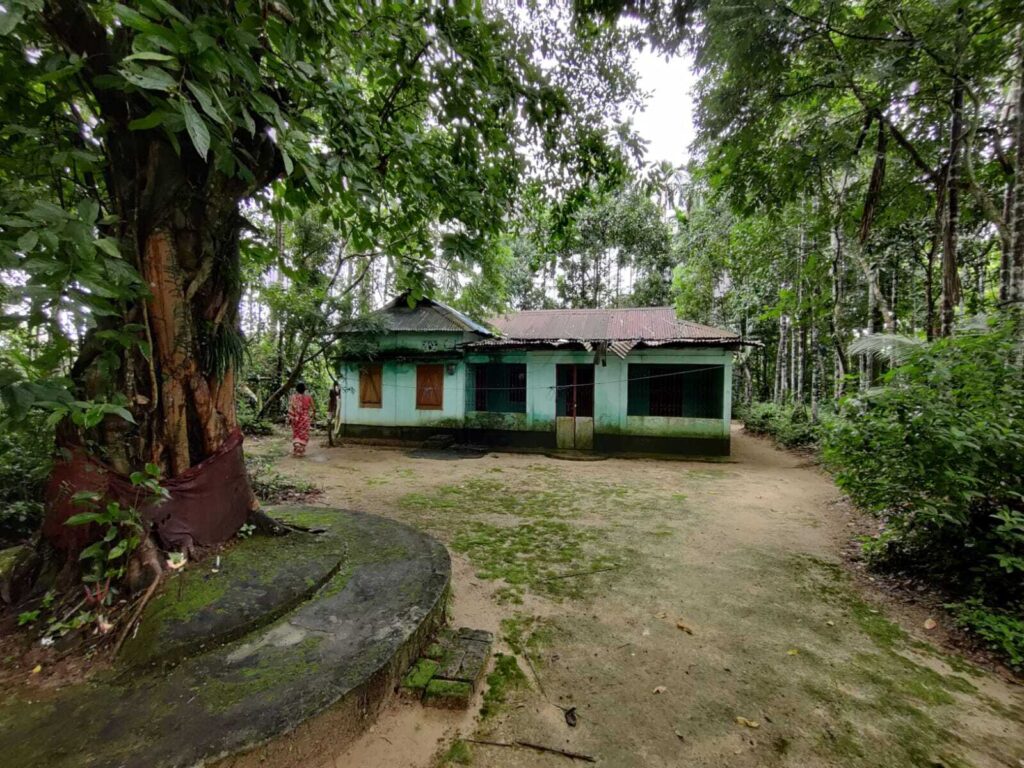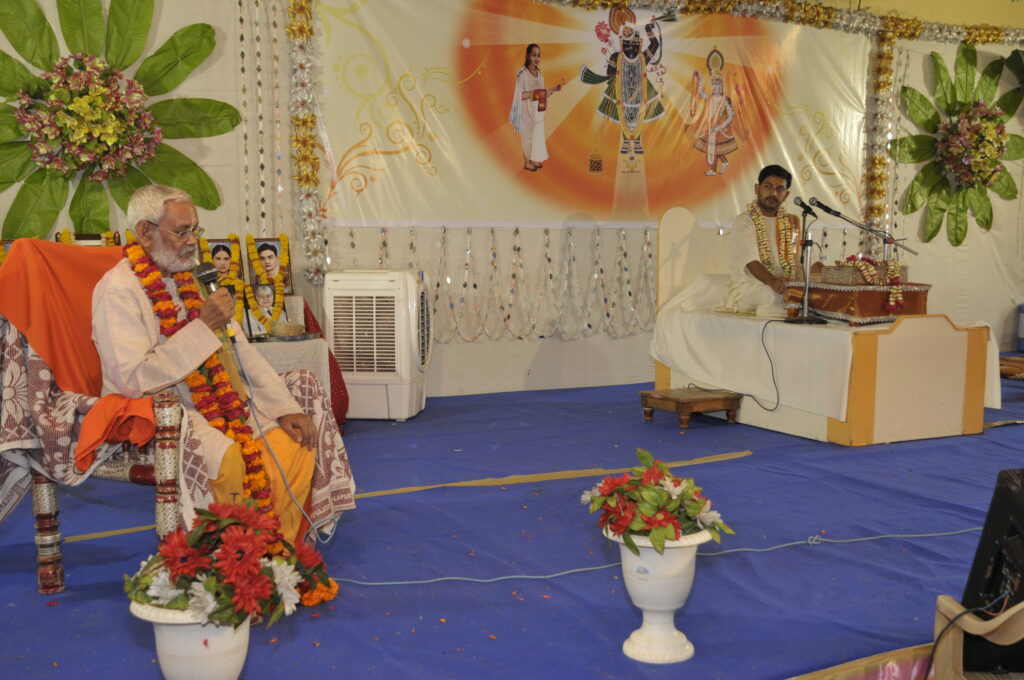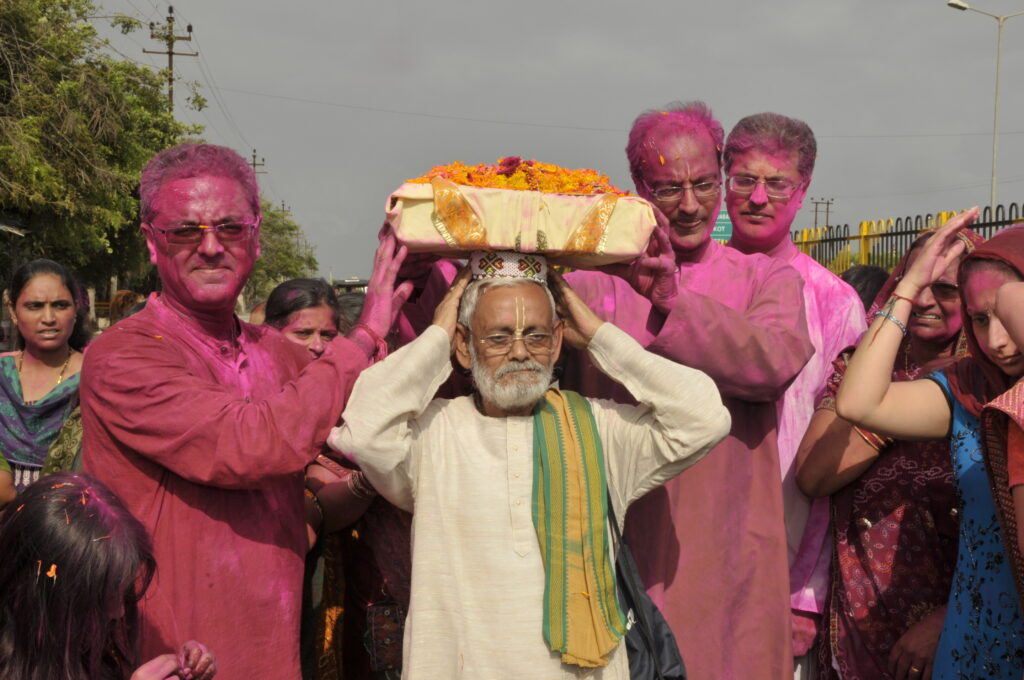
Mounibaba, during his lifetime, advised against establishing any institutions like Math or Mission in his name. He believed that such grand establishments might distract people from their spiritual growth, focusing instead on material concerns. He emphasized the importance of staying true to the path of spiritual upliftment, without being swayed by worldly endeavors. Many wealthy disciples, including the royal families of Bengal and others, expressed their desire to gift him vast stretches of land for the establishment of a grand ashram. They hoped to spread his teachings worldwide and maintain the close-knit community of devotees. Despite such offers, Mounibaba chose not to keep official records of his disciples’ names. On one occasion, he accepted such a generous gift but promptly donated the land to the victims of the Bengal Partition. This act of compassion stemmed from his merciful nature and profound empathy for those suffering, reflecting his deep concern for their well-being.


Establishment of Brahma Vidyashrama at Mansuka village
Anyways, an ashram was built for him at Mansuka village near Howrah, Bengal. It is situated on the banks of Damodar river, a very beautiful and favourable location similar to Dakshineshwar. Certainly the environment suited Mounibaba’s requirement for a calm and serene place. The land is kindly donated by his disciple Sri Mrityunjoy Manna in the year 1966. That Ashram was named as “Anandamoy Brahma Vidyashram”. Mounibaba used to stay at this ashram, while coming to Bengal. His disciples used to do omkar sadhana with him on this ashram, mostly on holidays and weekends. Still today, the divine presence of Maha Shakti is felt in this ashram. During his stay at Mansuka, Sri Sri Mounibaba extended heartfelt sympathy and assistance to the impoverished villagers. Monetary aid, clothing, and food were distributed generously, fostering a sense of kinship among the recipients, who regarded Sri Sri Mounibaba as their own. Through his blessings, the fortunes of these marginalized individuals were transformed, eliciting profound astonishment. Even today, there is eager anticipation for the further development and enhancement of this Ashram, envisioned as a beacon of devotion to God and self-improvement. During that time, prominent devotees like Biswanath Sen, Kalipada Das, Jivan Krishna Panja, Mrityunjoy Manna, Tarak Chandra Sen, Haridas Sadhu, etc. used to conduct festivals and other events at this ashram under the guidance of Mounibaba. They tried to maintain the devotee network strong via various communication channels. Mounibaba used to tell Biswanath Sen as his Hanuman. Biswanath Sen travelled to Himalayas 14 times to visit Mounibaba, when he was staying at his Rishikesh Ashram. His main goal was to maintain the strong network connection between all disciples of Mounibaba and transfer disciple’s messages/letters to Gurudev and vice versa.
In 1982, Mounibaba permanently shifted to Ranibari Ashram at Assam and stayed there till his Mahasamadhi on 1989. Then Gurudasi was mainly appointed to take complete care of Gurudev and all his requirements. Many devotees from Kolkata and other regions used to visit Mounibaba at Ranibari. Various festivals used to be conduct every year under the order and guidance of Mounibaba.
The Memorable Year of 1977 and Ranibari Kirtan


The year 1977 is a very memorable year for the devotees of Mounibaba. In the month of September, Mounibaba suddenly came from Rishikesh to Ranibari. Many devoted disciples like Haridas Sadhu, Biswanath Sen, etc. including Gurudas came to meet Mounibaba. During the day time, they were engaged to do guru seva and in the evening, Kirtania Anjali Raha, a favourite singer of Mounibaba, used to sing Kirtan and Bhajan to Gurudev in the praise of Radha and Krishna. Mounibaba used to sink in Bhava Samadhi listening to her songs and other devotees around also used to feel divine bliss. One day, he desired to arrange a long term kirtan doing Harinaam and Padavali.
Arrangements were made with great enthusiasm, as directed by the spiritual master. Villagers and devotees joined hands eagerly, offering their cooperation and services wholeheartedly. The eldest son of Gurudev Sri Rajat Kanti Chakraborty orchestrated the event meticulously, ensuring its success. Renowned singers such as Sri Ramendra Mohan Goswami and Srinam Kirtan party delivered soul-stirring Kirtan performances, drawing devotees from surrounding villages, tea gardens, and nearby towns, who partook in the devotional offerings with great reverence. Gurudev appointed Gurudas as the manager of the celebration, entrusting him with the responsibility of overseeing all puja rituals, including the significant sacrificial offerings conducted on the holy fire. Guided by Gurudev’s instructions, Gurudas meticulously executed all tasks.
A significant incident from the Kirtan at Ranibari is worth mentioning. In the early morning hours, Gurudev instructed Gurudas to perform the worship of Panchatattva and offer morning Bhog to the sacrificial fire. As he made his way back from the pond, carrying a jar of water, he encountered a large dog. Unintentionally, he invited the dog to join the Kirtan of Mahaprabhu and partake in the Mahaprashad. Surprisingly, the dog followed him and seemed to enjoy the Kirtan. During the Mahaprashad distribution later that day, he encountered the same dog, waiting expectantly to receive his share. Moved by the dog’s persistence, Gurudas offered him Mahaprashad with utmost devotion. The dog’s unique demeanor while consuming the Mahaprashad hinted at its divine nature. The following day, Gurudev revealed that the dog was none other than Mahatma Charandas Babaji, a revered devotee of Mahaprabhu Chaitanya Dev, who had assumed the form of a dog.
There are so many incidents related to this event, more details would be found on the biography book. The very brief outline of other events is just mentioned here – Mounibaba removes dark black cloud from sky, Mounibaba announces the arrival of Mahaprabhu and associates in the kirtan, 13 hours Bhava Samadhi of Gurudas, Mounibaba in long samadhi, Radharani and Mahaprabhu forcing Mounibaba to leave his material body permanently and go to Nitya Lila, but the decision being opposed by his guru Anandamoy Brahmachari in his subtle body and asking Mounibaba to stay more, etc. Overall, the year 1977 would always be remembered.
Mounibaba finally asks to form a Mission!
Next morning Gurudev surrounded by his disciples expressed his great pleasure on the successful celebration of Krishna kirtan, blessed them and also asked them to do the yogic practice with him. The atmosphere was divine. Then he told the disciples, “Well, you can form a mission”. “Is it possible Baba?”, questioned the disciples. “Why not” said Baba. He further said “suppose it has been formed now, since I have declared.” The Gurudev said that the name of the mission should be “Sri Anandamoy Mission”. But many devotees including Gurudas showed hesitation to this name, since name of Mounibaba was missing. Mounibaba just wanted to name the mission after his Sadguru “Anandamoy Brahmachari”. After discussion, name of the mission suggested by Gurudas as “Sri Sri Anandamoy Mounibaba Mission” was then approved by Gurudev in the midst of clapping and cheers by the devotees. However, the developmental work of the mission started practically after the demise of Gurudev, since his publicity was strictly prohibited during his life time.
Also very importantly, Mounibaba also authorized Gurudas on that day to initiate disciples in the Guru lineage of Mounibaba. Hence this year 1977 paved way and opened the door for new era!
Post Mounibaba Era
Official Establishment of Mission
Mounibaba took Mahasamadhi on 8th March, 1989 by doing Pranayam Kriya, leaving behind his keens in intense pain and torture. However as asked by him, Gurudas took the responsibility and started to engage himself completely to complete his unfulfilled desire, infact the burning desire to spread the glories of his dear Guru far and wide. Mounibaba totally rejected all pleas to publicise anything about him during his lifetime, even the short biography written by Gurudas on him.
Gurudasji retired from his Assam Riffles Job as Accounts Officer on 1995.


Gurudas ji created a house in Ranibari on his father’s land and made it his Yoga Ashram. On December 1st, 1997, Gurudas ji formally announced the establishment of the “Sri Sri Anandamoy Mounibaba Mission” or SRIAMM in a joyous ceremony. The event featured special Guru Puja, Hawan (sacrificial fire ceremony), recitations from the Gita, soulful Kirtan, collective prayers, and the distribution of Mahaprashad. Villagers and outsiders graciously attended this sacred occasion. Since then, the local community has become acquainted with the mission and its noble purpose.
Operating without official recognition or widespread publicity, the mission, supported by a small team of dedicated workers, has been striving to disseminate the teachings of Sri Sri Mounibaba. Occasional festivals and observances of significant dates related to Gurudev serve as opportunities to share his ideals with the community.
While the mission has yet to undertake large-scale social projects due to constraints in funding and manpower, it has been able to provide modest assistance to those in need. This includes monetary aid, distribution of clothing to the extremely impoverished, support for students, free coaching for underprivileged students, and offering free homeo-biochemic medical treatment. These efforts, albeit small in scale, have been made possible through individual contributions and resources.
Publication of the first Bengali Biography of Mounibaba

Gurudas visits United Kingdom!

Gurudas with family at UK
The memorable London Speech of Gurudas
During a gathering, younger individuals, led by Mr. Bhavesh Joshi, sought permission to hear about Hinduism for a brief 10 minutes. However, Gurudas found himself speaking for 25 minutes, much to everyone’s delight. English attendees, including MPs and the Mayor, expressed sincere appreciation, noting the enlightening nature of the lecture. Mr. Bhavesh Joshi, representing a diverse group of individuals from Gujarati, Chinese, Bengali, South African, and English backgrounds, was particularly impressed. He expressed a desire for further interactions, leading to arranged meetings with Gurudas, facilitated by Mr. Swagat Chakraborty. Eventually, Mr. Bhavesh Joshi and his wife, Mrs. Raksha Joshi, along with their daughters, Miss Iswarya and Miss Reshmi, became devoted disciples. Mrs. Rama Das, along with her son and daughter, also received initiation, illustrating how Sri Sri Mounibaba’s divine presence has touched the hearts of many.
The first Mounibaba temple is built at Ranibari


Formation of Mounibaba Samadhi Mandir
The samadhi mandir was also built on the area where Mounibaba’s body was given samadhi as part of last rites. It was constructed on March 2013, by the initiative of the sons of Mounibaba, followed by the contribution of others. It was also established with a one day kirtan, yajna and other activities,

Mounibaba Samadhi Mandir at night
Gurudas is invited to Bhagavat Saptah at Bhavesh Joshi’s house in Gujarat




Formation of Trustee and official registration of SRIAMM

Formation of Shiva Mandir at Mansuka

